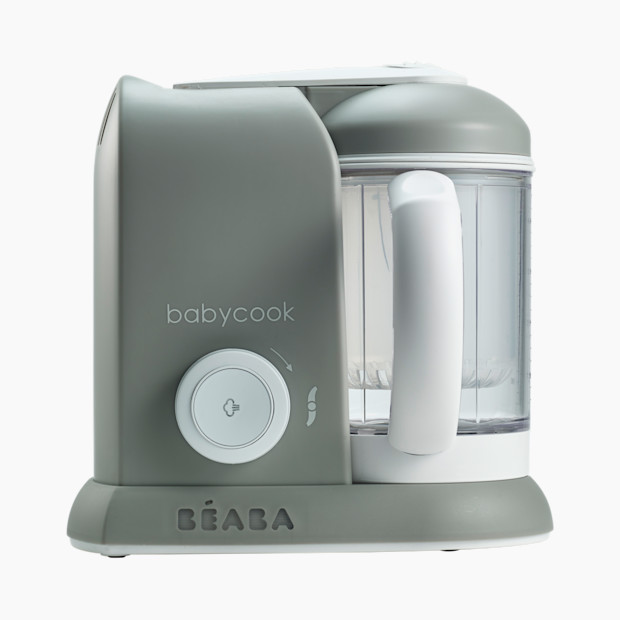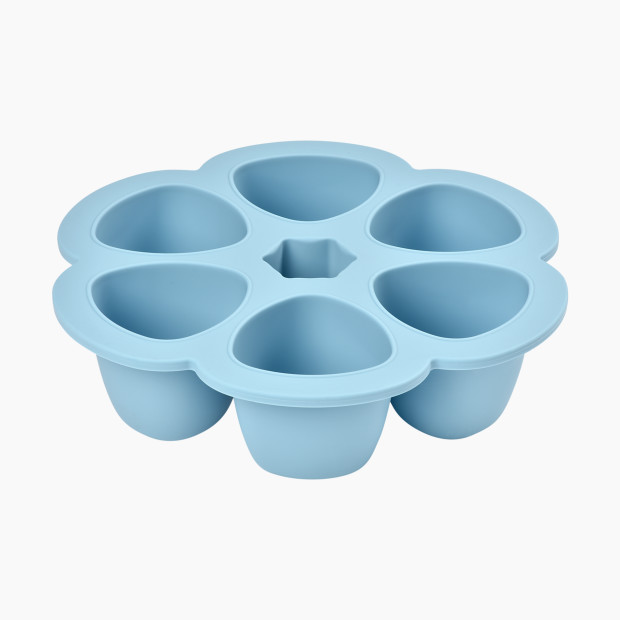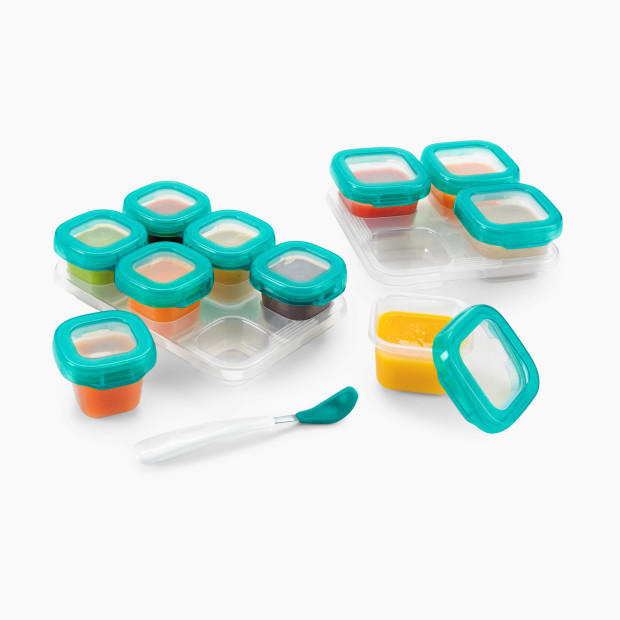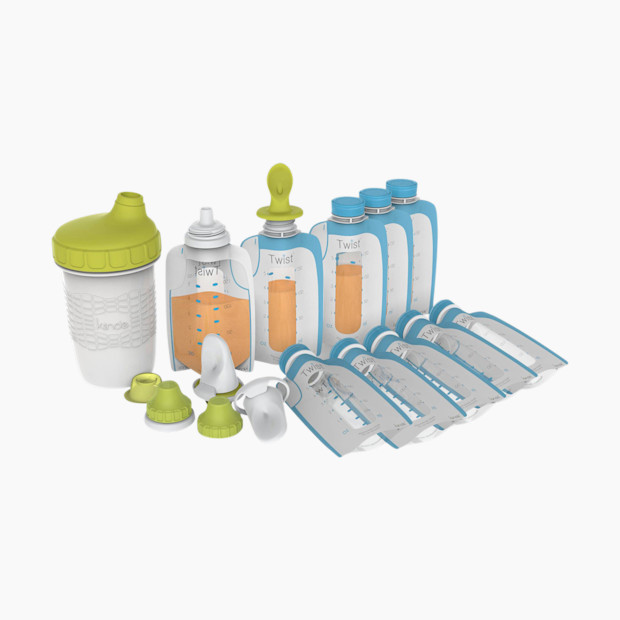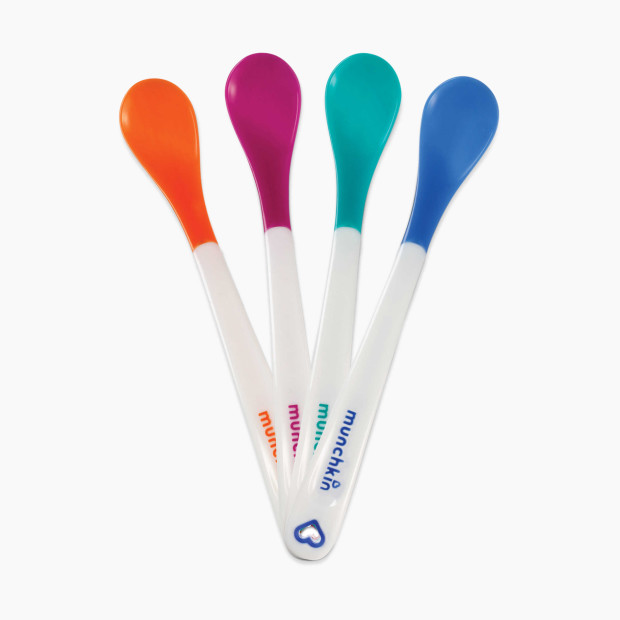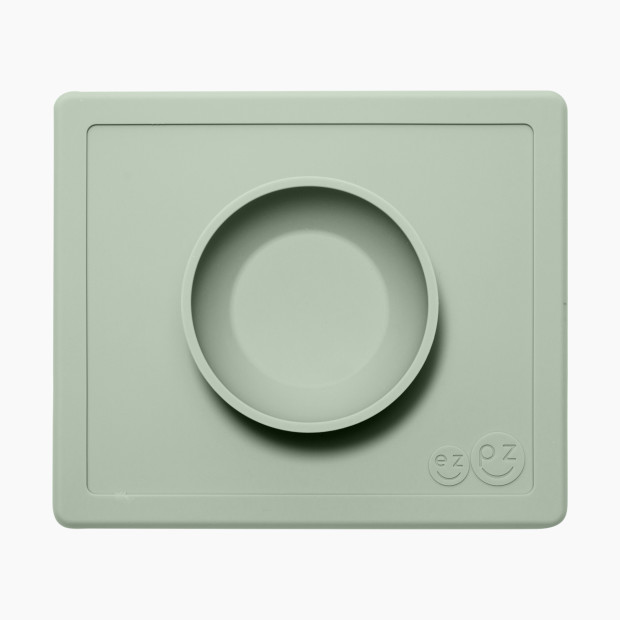
How to Make Your Own Baby Food
Wash, steam, blend, serve. Making homemade baby food is a lot easier than you might think.

In This Article
So your ever-growing, formula- and/or breastmilk-guzzling infant is ready for the next step in their eating journey. Maybe they readily open their mouth when they see food approaching, or maybe you’ve noticed tiny fingers reaching for what’s on your plate at dinnertime. Whatever signs you’re seeing that your baby is ready for solid food, you have a few options for introducing it to them, including making your own at home.
Though traditional baby food jars and newer squeeze pouches are a great way to help your baby transition from milk to solids, they can get expensive pretty quickly, and making your own baby food at home is easier than it sounds, especially with the right tools and advice.
We asked Jennifer Anderson, pediatric nutritionist, mom and founder of Kids Eat In Color (@kids.eat.in.color on Instagram) about how to prepare homemade baby food and make sure your baby is getting the most nutrients out of every meal.
How to Make Your Own Baby Food
Cooking solid foods and blending them into purees takes about as much time as cooking dinner for yourself, and it can be done right alongside your own meals. You can even make your baby’s food out of most of the things you’re serving yourself, especially if your meals feature plenty of fruits and veggies.
To prep food for homemade baby purees:
1. Wash and Peel
Wash any fresh food items and peel any fruits or veggies that have a skin or peel (like apples, carrots or potatoes). If you’re using frozen fruits or vegetables, no need to wash or cut them—just pop them directly into the steamer and go from there.
2. Chop
Cut the food into bite-size pieces.
3. Steam
Steam the food over one inch of water—either on the stovetop with a steamer basket, in a microwave steamer bag, in a pressure cooker with steaming capabilities or using a baby food maker—until the food is fork tender (soft enough to mash with a fork, usually after being steamed for about 10 minutes, potentially less).
4. Drain
Drain the cooking liquid, but add a little bit of the liquid back into the blender with the rest of the cooked food to add some of the nutrients that were lost during cooking. (For thicker or grainier foods, like squash, putting some of the cooking liquid back into the puree can also help make it smoother.)
5. Puree
Puree the food using a blender (full-size or immersion), food processor or baby food maker. You’ll want the smoothest consistency possible for younger babies. Once your baby is ready for a chunkier texture, you can mash it with a fork or baby food masher.
6. Store
Refrigerate any leftovers, or freeze to build up a meal stash. Here are our picks for the best baby and toddler food storage.
How to Start Solids
Many families start their babies with cereal to transition from milk to solids, but don’t be afraid to jump right into foods that you would eat too, like applesauce or pureed, steamed carrots. The puree phase only lasts for a few weeks or months—if you decide to do it at all.
Some parents jump right into soft, steamed bite sizes of food, but purees are a common place to start when introducing your baby to solids, especially to help them gain spoon-eating skills and tongue reflexes.
But don’t keep your baby in the puree phase for too long, Anderson says. “Purees don't help babies get used to different textures, and keeping them in the puree phase can increase their chances of more picky eating behaviors later.”
She recommends exposing your baby to different textures early on to get them used to eating a variety of textures. “Move on to less pureed foods as quickly as you can—as in start with purees and within a few weeks start to slowly make changes to the textures week by week.”
How to Make Healthy Baby Food
It’s pretty obvious that babies’ tiny tummies need less food than adults, but there’s no need to count calories for your little one. The thing to pay attention to with your baby’s food is the nutrient density, or the amount of nutrients (vitamins, minerals and protein) per 100 calories. So what are the nutrition requirements of a new solid food eater, and how can you preserve all the nutrients in your homemade baby food? We asked, and Jennifer Anderson answered.
How do the nutritional needs of a baby differ from those of an adult?
“Babies have small stomachs, so they need nutrient dense food that gives them lots of nutrients in a small amount. They also need plenty of iron-rich foods in their diet for brain development.”
Some nutrient-dense foods include blueberries, avocados, egg yolks, salmon, kale, spinach, broccoli, carrots, cantaloupe, strawberries, sweet potatoes and full-fat yogurt.
How can parents ensure their child is getting the right nutrition if they’re making their own baby food vs. giving their child store-bought baby food?
“If you are using nutrient dense foods like fruits, vegetables, meats and full-fat dairy, your baby food will be nutrient dense. Some store-bought baby food is iron-fortified, like baby oatmeal cereal. So, if you are making your own baby food you need to make sure you have iron-rich foods in them like meats, beans and dark leafy greens.”
What’s the best way to prepare homemade baby food to preserve the most nutrients?
“Cook the baby food for as short a time as you can to process it or make it safe for baby to eat as finger food.”
Most foods will steam to fork-tenderness in about 10 minutes, but you can check it continuously to find the moment it’s ready, so you prevent overcooking the food and depleting the nutrients.
You can use fresh foods, frozen foods or canned. “Frozen fruits and veggies are just as nutritious as fresh fruits and veggies,” says Anderson. “Canned veggies and fruits do have less nutrients, but they are still nutritious and are a good choice for kids.” When using canned foods, she recommends choosing low sodium options, and for babies, rinsing the food before serving.
Is there any kind of special cooking equipment (baby food makers, blenders, steamers, etc) you would recommend for maintaining the highest amount of nutrients? What about for ease of cooking?
“Personally, the only baby food ‘gear’ I used was a baby food grinder,” Anderson says. “Sometimes, it's easiest to make normal food for the family and if it's not safe for baby to eat like that, you can put it in a hand grinder at the table and grind it up for the baby. A few times I used our normal food processor to make something into a puree, but it was easier for me to use family food most of the time.”
Baby food makers like the Beaba BabyCook can save you a little bit of time and dishes in the long run, since you can steam and puree ingredients in the same basket, but even if you just have a stovetop steamer basket and a regular blender or masher, the general idea is the same: steam some vegetables, mash them up and store individual portions.
What About Food Allergies in Babies?
How should parents approach common allergy foods in their homemade purees? Is there a particular way to prepare them?
“‘Early and often’ is the recommendation for introducing potentially allergenic foods. If your family has a history of food allergy, it's a good idea to talk to your pediatrician or allergist first,” Anderson recommends. Otherwise, include common allergenic foods like eggs, peanuts, soy and dairy products like cheese and yogurt (but no cow’s milk until baby is at least 12 months old) in the baby's food rotation and purees. “There is no specific way to prepare them as long as the texture will not cause choking.”
Creative Baby Food Recipes
Homemade baby food doesn’t have to just be plain pureed peas or bananas served by themselves. Just like any regular meal for adults, big kids or toddlers, you can serve your baby a variety of foods in the same meal so they get a taste of lots of different flavors and textures (pumpkin, banana and cinnamon, anyone?).
Need some inspiration? We’re fans of these combos, and give these recipes a try, too.
Is there a nutritional advantage to combining certain foods into baby purees?
“Yes, always combine an iron-rich food with a vitamin C food,” Anderson says. Vitamin C has been shown to help your body absorb iron in food.
We’re fans of combinations like black beans and bell peppers, kale + spinach + berries (like a fruit smoothie for babies!), iron-fortified cereal and strawberries or dark meat chicken and sweet potatoes (dark meat has more moisture than white meat and is easier for younger babies to chew when mushed together with water and other moist foods).
What Do You Need for Starting Solids?
Just like with any store-bought puree, you’re going to need a set of good baby spoons that are sized for tiny mouths. Shallow spoons generally work better for younger babies since they don’t need as much food scooped into their mouths at one time, while deeper spoons make better mouthfuls for toddlers who are already mastering self-feeding. Also consider soft-tipped spoons that are gentle on teething gums, or spoons that will tell you if the food is too hot for baby to eat.
You’ll also need a bowl or plate to serve the food on, and since babies are notoriously messy eaters, lots of parents love dishware that can suction to the table so grabby little hands don’t knock it to the floor. Most dishware sets made for babies and toddlers are sized to their serving needs, but it’s still important to keep an eye on your baby’s cues for how much food they actually want to eat (i.e. don’t fill the entire bowl at every meal; that leads to food waste).
How should parents portion their homemade baby food?
“Each baby will need a different amount of food. Watch your baby’s cues. Are they grabbing for the spoon and sticking it in their mouth? Are they asking for more with their body language? Are they opening their mouth and putting their head forward? All these things mean they want more and you can give them more. When they lose interest and shut their mouth, stop feeding them.”
“Remember your baby knows the amount of food that they need. So let them decide whether they will eat and how much they will eat. As soon as they start eating solids, serve the solids on a consistent routine that will eventually become a meal and snack schedule. Also, if you start with purees, don't get stuck on purees. Pureed food is just a short phase to get them eating table food (with a safe shape and texture). Move them along from pureed food to table food as quickly as they can manage it. Just make sure that you know how to serve table foods safely to toddlers and that you avoid choking hazards as they move to table food.”
How to Store and Freeze Leftover Baby Food
What’s the best way to store homemade baby food to preserve the most nutrients and increase longevity?
“Storing it in the refrigerator is great for a few days of use, even for meat-based baby food. You can store it in the freezer to use over a longer period of time.” Small, freezer-safe food storage containers like this 12-Piece Freezer Baby Blocks Set from Oxo Tot or Beaba’s ice-cube-like multiportions tray are perfect for storing individual portions both in the fridge and freezer.
If you’ve stored individual portions in the freezer, when it comes time to defrost and serve, Anderson recommends two defrost methods: place the container in the fridge for a day, or hold it under warm running water (just like you might have warmed up frozen breast milk or a refrigerated formula bottle).
For easy store-and-serve, check out the Kinde Foodii Squeeze Starter Kit that allows you to make your own squeeze pouches for less money than buying the ones at the supermarket. They even have a special flexible spoon spout that can help your baby get used to a spoonlike shape while still using a similar sucking reflex they used on their bottles or when breastfeeding.

